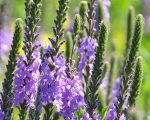
Hoary vervain is a herbaceous perennial and a member of the vervain family, Verbanaceae, that also includes lantanas, s verbenas, and sandpaper vines. It is native to the Midwest, the Great Plains, and Texas where it grows in meadows, fields, and disturbed sites such as roadsides and railroad right-of ways. Plants often form colonies by self-seeding and make valuable garden plants especially in wildlife gardens where they are a larval host and nectar source for butterflies and provide seeds for small birds and mammals. Hoary verbena may become weedy, however, especially in dry poor disturbed soil.
Description: Plants grows in clumps two to four feet tall and have branched stems with four inch long ovate leaves that are directly attached to the stem and have coarsely toothed margins. Both stems and leaves are covered with white hairs. Small purplish flowers 1/2″ long appear in densely packed terminal panicles from May to September, (primarily in summer) when they bloom a few at a time from the bottom to the top of the panicle. Plants spread by seed and rhizomes.
Control: Mulch to inhibit germination of seeds in the ground. Hoe or pull seedlings as they appear and dig larger plants being careful to remove the rhizomes. Mowing plants once or twice a season when they are three to five inches tall can control the vervain population although not eliminate it. In severe cases herbicides can be used and are especially effective when applied to plants that are three to five inches tall.